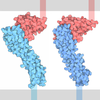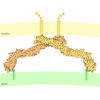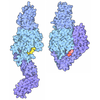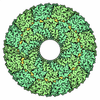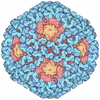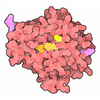+ Open data
Open data
- Basic information
Basic information
| Entry | Database: PDB / ID: 8i9m | ||||||
|---|---|---|---|---|---|---|---|
| Title | The RAGE and HMGB1 complex | ||||||
 Components Components |
| ||||||
 Keywords Keywords | IMMUNE SYSTEM / RAGE / HMGB1 / Inflammation | ||||||
| Function / homology |  Function and homology information Function and homology information: / regulation of tolerance induction / calcium-dependent protein kinase regulator activity / positive regulation of myeloid progenitor cell differentiation / regulation of T cell mediated immune response to tumor cell / positive regulation of mismatch repair / advanced glycation end-product receptor activity / negative regulation of blood circulation / positive regulation of endothelin production / regulation of CD4-positive, alpha-beta T cell activation ...: / regulation of tolerance induction / calcium-dependent protein kinase regulator activity / positive regulation of myeloid progenitor cell differentiation / regulation of T cell mediated immune response to tumor cell / positive regulation of mismatch repair / advanced glycation end-product receptor activity / negative regulation of blood circulation / positive regulation of endothelin production / regulation of CD4-positive, alpha-beta T cell activation / negative regulation of apoptotic cell clearance / plasmacytoid dendritic cell activation / negative regulation of RNA polymerase II transcription preinitiation complex assembly / myeloid dendritic cell activation / glucose mediated signaling pathway / T-helper 1 cell activation / positive regulation of monocyte extravasation / regulation of T cell mediated cytotoxicity / T-helper 1 cell differentiation / positive regulation of DNA-templated DNA replication / positive regulation of myeloid cell differentiation / positive regulation of toll-like receptor 2 signaling pathway / negative regulation of long-term synaptic depression / positive regulation of dendritic cell differentiation / regulation of p38MAPK cascade / C-X-C chemokine binding / negative regulation of CD4-positive, alpha-beta T cell differentiation / positive regulation of toll-like receptor 9 signaling pathway / neutrophil clearance / regulation of non-canonical NF-kappaB signal transduction / positive regulation of amyloid precursor protein catabolic process / positive regulation of glycogen catabolic process / DNA geometric change / positive regulation of toll-like receptor 4 signaling pathway / endothelial cell chemotaxis / transcytosis / RAGE receptor binding / eye development / positive regulation of interleukin-1 production / Regulation of TLR by endogenous ligand / bubble DNA binding / induction of positive chemotaxis / V(D)J recombination / myeloid cell differentiation / alphav-beta3 integrin-HMGB1 complex / Apoptosis induced DNA fragmentation / myeloid progenitor cell differentiation / inflammatory response to antigenic stimulus / macrophage activation involved in immune response / positive regulation of monocyte chemotaxis / MyD88 deficiency (TLR2/4) / positive regulation of heterotypic cell-cell adhesion / regulation of nucleotide-excision repair / positive regulation of monocyte chemotactic protein-1 production / S100 protein binding / positive regulation of p38MAPK cascade / regulation of long-term synaptic potentiation / cellular response to interleukin-7 / endothelial cell proliferation / positive regulation of chemokine (C-X-C motif) ligand 2 production / protein localization to membrane / glycogen catabolic process / apoptotic cell clearance / supercoiled DNA binding / regulation of spontaneous synaptic transmission / positive regulation of vascular endothelial cell proliferation / negative regulation of connective tissue replacement involved in inflammatory response wound healing / DNA binding, bending / IRAK4 deficiency (TLR2/4) / dendritic cell chemotaxis / scavenger receptor activity / MyD88:MAL(TIRAP) cascade initiated on plasma membrane / positive regulation of DNA binding / laminin receptor activity / positive regulation of wound healing / phosphatidylserine binding / negative regulation of interleukin-10 production / positive regulation of double-strand break repair / positive regulation of sprouting angiogenesis / chemoattractant activity / endoplasmic reticulum-Golgi intermediate compartment / positive regulation of activated T cell proliferation / response to amyloid-beta / TRAF6 mediated NF-kB activation / negative regulation of type II interferon production / DNA topological change / Advanced glycosylation endproduct receptor signaling / positive regulation of interferon-alpha production / negative regulation of long-term synaptic potentiation / positive regulation of interleukin-10 production / negative regulation of blood vessel endothelial cell migration / protein kinase activator activity / positive regulation of blood vessel endothelial cell migration / Pyroptosis / phagocytosis / phagocytic cup / transport across blood-brain barrier / positive regulation of chemokine production / four-way junction DNA binding / condensed chromosome Similarity search - Function | ||||||
| Biological species |  Homo sapiens (human) Homo sapiens (human) | ||||||
| Method | ELECTRON MICROSCOPY / single particle reconstruction / cryo EM / Resolution: 5.19 Å | ||||||
 Authors Authors | Han, C.W. / Kim, H.J. | ||||||
| Funding support | 1items
| ||||||
 Citation Citation |  Journal: To Be Published Journal: To Be PublishedTitle: The RAGE and HMGB1 complex Authors: Han, C.W. / Kim, H.J. | ||||||
| History |
|
- Structure visualization
Structure visualization
| Structure viewer | Molecule:  Molmil Molmil Jmol/JSmol Jmol/JSmol |
|---|
- Downloads & links
Downloads & links
- Download
Download
| PDBx/mmCIF format |  8i9m.cif.gz 8i9m.cif.gz | 65 KB | Display |  PDBx/mmCIF format PDBx/mmCIF format |
|---|---|---|---|---|
| PDB format |  pdb8i9m.ent.gz pdb8i9m.ent.gz | 44.9 KB | Display |  PDB format PDB format |
| PDBx/mmJSON format |  8i9m.json.gz 8i9m.json.gz | Tree view |  PDBx/mmJSON format PDBx/mmJSON format | |
| Others |  Other downloads Other downloads |
-Validation report
| Summary document |  8i9m_validation.pdf.gz 8i9m_validation.pdf.gz | 965.3 KB | Display |  wwPDB validaton report wwPDB validaton report |
|---|---|---|---|---|
| Full document |  8i9m_full_validation.pdf.gz 8i9m_full_validation.pdf.gz | 984.9 KB | Display | |
| Data in XML |  8i9m_validation.xml.gz 8i9m_validation.xml.gz | 26 KB | Display | |
| Data in CIF |  8i9m_validation.cif.gz 8i9m_validation.cif.gz | 36.1 KB | Display | |
| Arichive directory |  https://data.pdbj.org/pub/pdb/validation_reports/i9/8i9m https://data.pdbj.org/pub/pdb/validation_reports/i9/8i9m ftp://data.pdbj.org/pub/pdb/validation_reports/i9/8i9m ftp://data.pdbj.org/pub/pdb/validation_reports/i9/8i9m | HTTPS FTP |
-Related structure data
| Related structure data |  35276MC M: map data used to model this data C: citing same article ( |
|---|---|
| Similar structure data | Similarity search - Function & homology  F&H Search F&H Search |
- Links
Links
- Assembly
Assembly
| Deposited unit | 
|
|---|---|
| 1 |
|
- Components
Components
| #1: Protein | Mass: 8590.859 Da / Num. of mol.: 1 Source method: isolated from a genetically manipulated source Source: (gene. exp.)  Homo sapiens (human) / Gene: HMGB1, HMG1 / Production host: Homo sapiens (human) / Gene: HMGB1, HMG1 / Production host:  |
|---|---|
| #2: Protein | Mass: 23068.414 Da / Num. of mol.: 1 Source method: isolated from a genetically manipulated source Source: (gene. exp.)  Homo sapiens (human) / Gene: AGER, RAGE / Production host: Homo sapiens (human) / Gene: AGER, RAGE / Production host:  |
| Has protein modification | Y |
-Experimental details
-Experiment
| Experiment | Method: ELECTRON MICROSCOPY |
|---|---|
| EM experiment | Aggregation state: PARTICLE / 3D reconstruction method: single particle reconstruction |
- Sample preparation
Sample preparation
| Component | Name: The RAGE and HMGB1 complex / Type: COMPLEX / Entity ID: all / Source: RECOMBINANT |
|---|---|
| Molecular weight | Value: 0.50 MDa / Experimental value: YES |
| Source (natural) | Organism:  Homo sapiens (human) Homo sapiens (human) |
| Source (recombinant) | Organism:  |
| Buffer solution | pH: 8 |
| Specimen | Embedding applied: NO / Shadowing applied: NO / Staining applied: NO / Vitrification applied: YES |
| Specimen support | Grid material: GOLD / Grid mesh size: 200 divisions/in. / Grid type: Quantifoil R2/2 |
| Vitrification | Cryogen name: NITROGEN |
- Electron microscopy imaging
Electron microscopy imaging
| Microscopy | Model: TFS GLACIOS |
|---|---|
| Electron gun | Electron source:  FIELD EMISSION GUN / Accelerating voltage: 200 kV / Illumination mode: FLOOD BEAM FIELD EMISSION GUN / Accelerating voltage: 200 kV / Illumination mode: FLOOD BEAM |
| Electron lens | Mode: DARK FIELD / Nominal defocus max: 3000 nm / Nominal defocus min: 1800 nm |
| Image recording | Electron dose: 39.99 e/Å2 / Film or detector model: FEI FALCON III (4k x 4k) |
- Processing
Processing
| Software |
| ||||||||||||||||||||||||
|---|---|---|---|---|---|---|---|---|---|---|---|---|---|---|---|---|---|---|---|---|---|---|---|---|---|
| CTF correction | Type: PHASE FLIPPING AND AMPLITUDE CORRECTION | ||||||||||||||||||||||||
| 3D reconstruction | Resolution: 5.19 Å / Resolution method: FSC 0.143 CUT-OFF / Num. of particles: 121467 / Symmetry type: POINT | ||||||||||||||||||||||||
| Refinement | Stereochemistry target values: CDL v1.2 | ||||||||||||||||||||||||
| Refine LS restraints |
|
 Movie
Movie Controller
Controller



 PDBj
PDBj

